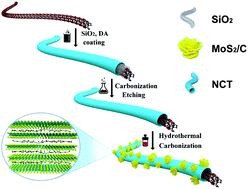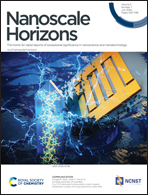Inter-overlapped MoS2/C composites with large-interlayer-spacing for high-performance sodium-ion batteries†
Abstract
As a two-dimensional layered material with a structure analogous to that of graphene, molybdenum disulfide (MoS2) holds great promise in sodium-ion batteries (SIBs). However, recent research findings have revealed some disadvantages in two-dimensional (2D) materials such as poor interlayer conductivity and structural instability, resulting in poor rate performance and short cycle life for SIBs. Herein, we designed MoS2 nanoflowers with an ultra-wide spacing interlayer (W-MoS2/C) anchored on special double carbon tubes to construct three-dimensional (3D) nanostructures. When tested as an anode material in a SIB, the as-prepared CNT@NCT@W-MoS2/C sample achieves high capacities (530 and 230 mA h g−1 at current densities of 0.1 and 2 A g−1, respectively). Density functional theory (DFT) calculations demonstrate that the ultra-wide spacing MoS2/C structure is beneficial for the chemical adsorption of sodium ions and facilitates redox reactions. The wide interlayer spacing and the presence of an intermediate carbon layer provide a rapid diffusion channel for ions and offer a free space for volume expansion of the electrode material.



 Please wait while we load your content...
Please wait while we load your content...